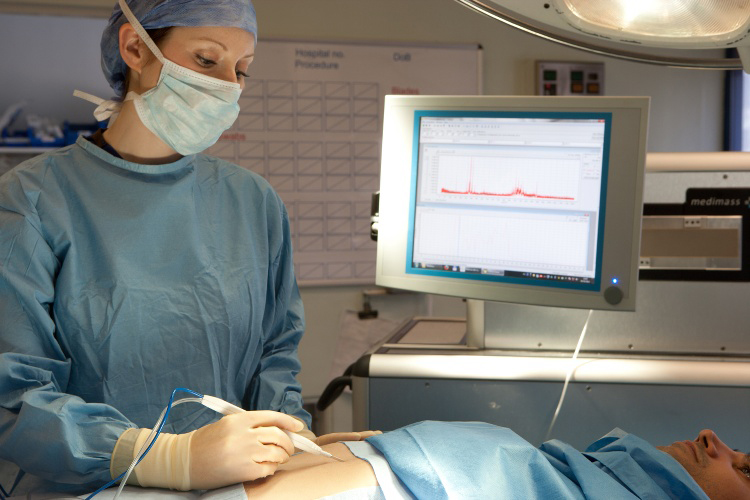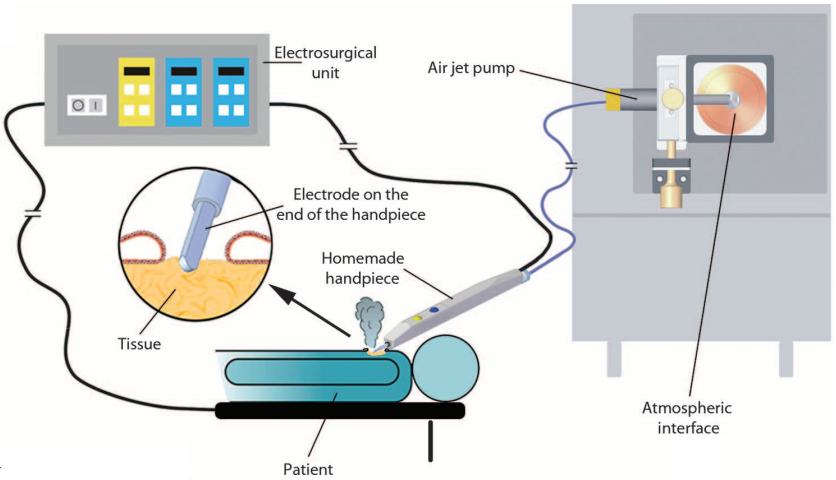‘Intelligent knife’ tells surgeon if tissue is cancerous in 3 seconds
July 19, 2013

(Credit: Imperial College London)
Scientists have developed an “intelligent knife” (iKnife) that can tell surgeons immediately whether the tissue they are cutting is cancerous or not.
In the first study to test the iKnife invention (based on “rapid evaporative ionization mass spectrometry (REIMS)) in the operating theater, iKnife diagnosed tissue samples from 91 patients with 100 per cent accuracy.
It instantly (within 3 seconds) provided information that normally takes up to half an hour to reveal using laboratory tests.
The iKnife is based on electrosurgery, a technology invented in the 1920s that is commonly used today. Electrosurgical knives use an electrical current to rapidly heat tissue, cutting through it while minimizing blood loss. In doing so, they vaporize the tissue, creating smoke that is normally sucked away by extraction systems.
The inventor of the iKnife, Dr Zoltan Takats of Imperial College London, realized that this smoke would be a rich source of biological information. To create the iKnife, he connected an electrosurgical knife to a mass spectrometer, an analytical instrument used to identify what chemicals are present in a sample. Different types of cell produce thousands of metabolites in different concentrations, so the profile of chemicals in a biological sample can reveal information about the state of that tissue.

. Schematic of iKnife experimental system using monopolar electrosurgery (credit: Imperial College London/Science Translational Medicine)
In the new study, the researchers first used the iKnife to analyze tissue samples collected from 302 surgery patients, recording the characteristics of thousands of cancerous and non-cancerous tissues, including brain, lung, breast, stomach, colon and liver tumors, to create a reference library. The iKnife works by matching its readings during surgery to the reference library to determine what type of tissue is being cut, giving a result in less than three seconds.
The technology was used in the operating theater to perform real-time analysis during surgery. In all 91 tests, the tissue type identified by the iKnife matched the post-operative diagnosis based on traditional methods.
While the iKnife was being tested, surgeons were unable to see the results of its readings. The researchers hope to carry out a clinical trial to see whether giving surgeons access to the iKnife’s analysis can improve patients’ outcomes.
“These results provide compelling evidence that the iKnife can be applied in a wide range of cancer surgery procedures,” Dr Takats said. “It provides a result almost instantly, allowing surgeons to carry out procedures with a level of accuracy that hasn’t been possible before. We believe it has the potential to reduce tumor recurrence rates and enable more patients to survive.”
Although the current study focused on cancer diagnosis, Dr Takats says the iKnife can identify many other features, such as tissue with an inadequate blood supply, or types of bacteria present in the tissue. He has also carried out experiments using it to distinguish horsemeat from beef.
Professor Jeremy Nicholson, Head of the Department of Surgery and Cancer at Imperial College London, who co-authored the study, said: “The iKnife is one manifestation of several advanced chemical profiling technologies developed in our labs that are contributing to surgical decision-making and real-time diagnostics. These methods are part of a new framework of patient journey optimization that we are building at Imperial to help doctors diagnose disease, select the best treatments, and monitor individual patients’ progress as part our personalized healthcare plan.”
More than 300,000 new cancer cases are diagnosed in the United Kingdom each year, and 1.8 million diagnostic, curative, or palliative surgical procedures are performed as part of their treatment.
In cancers involving solid tumors, removal of the cancer in surgery is generally the best hope for treatment. The surgeon normally takes out the tumor with a margin of healthy tissue. However, it is often impossible to tell by sight which tissue is cancerous. One in five breast cancer patients who have surgery require a second operation to fully remove the cancer. In cases of uncertainty, the removed tissue is sent to a lab for examination while the patient remains under general anesthetic.
The study was funded by the National Institute for Health Research (NIHR) Imperial Biomedical Research Centre, the European Research Council and the Hungarian National Office for Research and Technology.